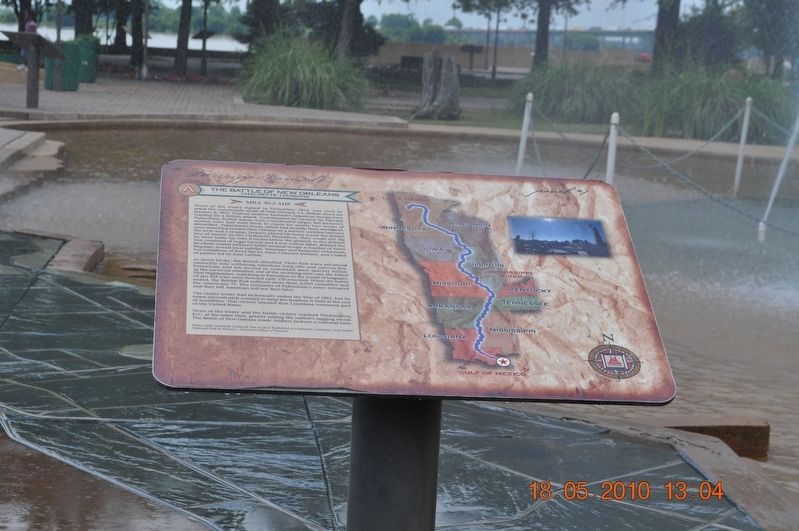Memphis in Shelby County, Tennessee — The American South (East South Central)
The Battle of New Orleans
Chalmette, Louisiana
— Panel #7 Mississippi Riverwalk —
Mile 90.2 AHP
Word of the treaty signed in December 1814, was slow to reach the countryside south of New Orleans, LA. Before dawn on January 8, 1815, General Andrew Jackson’s American troops were waiting for a British attack. Commanded by General Sir Edward Pakenham, British forces were considerably larger, but Jackson’s motley crew had them in check for nearly two weeks of a skirmish. Pakenham’s forces, which had recently been reinforced, were marching toward New Orleans on a narrow corridor between the river and a swamp. Jackson placed his army across the British line of march on the Chalmette Plantation. They could not dig in, since water lay 8 inches below the ground, so the defensive line consisted of sugar barrels and a few cotton bales. Behind the blockage waited Jackson’s 6.000 unusual troops: a number of Army Regulars, several local militias, Tennessee and Kentucky volunteers, two battalions of freed blacks, some Choctaw Indians, and a band of pirates led by Jean Lafitte.
As dawn broke, the British attacked. Their first wave advanced staunchly into withering American long rifle and cannon fire. Pakenham and his second in command were quickly killed. As the survivors retreated, out of the morning mist came the kilted 93rd Highlanders, marching in formation to the sound of bagpipes. Of the 925 who went forward only 130 returned. When the battle ended, the British had suffered more than 2,000 casualties and they left America soil ten days later.
The earlier treaty had technically ended the War of 1812, but its terms allowed each country to keep the territory it held at the end of hostilities. This victory ensured that Louisiana remained part of the United States.
New to the treaty and the battle victory reached Washington, D. C. At the same time, greatly raising the nation ’s sagging morale. The Battle of New Orleans made Andrew Jackson a national hero.
Photo Credit: American Canon at War of 1812 Battlefield at Chalmette, Louisiana/Jean Lafitte National Park & Preserve - Louisiana Office of Tourism
Erected by Mississippi Riverwalk. (Marker Number 7.)
Topics and series. This historical marker is listed in these topic lists: Native Americans • War of 1812 • Waterways & Vessels. In addition, it is included in the Former U.S. Presidents: #07 Andrew Jackson series list. A significant historical date for this entry is January 8, 1815.
Location. 35° 8.968′ N, 90° 3.507′ W. Marker is in Memphis, Tennessee, in Shelby County. Marker can be reached from Island Drive, 0.8 miles south of West A.W. Willis Avenue when traveling south. Located in Mud Island River Park. Touch for map. Marker is at or near this postal address: 125 N Front St, Memphis TN 38103, United States of America. Touch for directions.
Other nearby markers. At least 8 other markers are within walking distance of this marker. The Mississippi Riverwalk (here, next to this marker); Ohio River (here, next to this marker); Cairo, Illinois (here, next to this marker); Islands No. 2, 3, and 4 / Fort Jefferson, Kentucky / Bird’s Point, Missouri (here, next to this marker); Island No. 5 (Wolf Island)/Belmont, Missouri/Columbus, Kentucky (here, next to this marker); Donaldson Point, Missouri/Island No. 8/Hickman, Kentucky/Dorena Crevasse (here, next to this marker); New Madrid, Missouri/Cates Casting Field/Island No. 10 (here, next to this marker); Tiptonville, Tennessee/Bixby Towhead (here, next to this marker). Touch for a list and map of all markers in Memphis.
Also see . . . Battle of New Orleans. By December 12, 1814, sixty British ships with 14,450 soldiers and sailors aboard, under the command of Admiral Sir Alexander Cochrane, had anchored in the Gulf of Mexico to the east of Lake Pontchartrain and Lake Borgne.[4][18] Preventing access to the lakes was an American flotilla, commanded by Lieutenant Thomas ap Catesby Jones, consisting of five gunboats. On December 14, around 1,200 British sailors and Royal Marines under Captain Nicholas Lockyer[19] set out to attack Jones' force. Lockyer's men sailed in 42 longboats, each armed with a small carronade. (Submitted on March 12, 2018, by Sandra Hughes Tidwell of Killen, Alabama, USA.)
Credits. This page was last revised on March 13, 2018. It was originally submitted on March 12, 2018, by Sandra Hughes Tidwell of Killen, Alabama, USA. This page has been viewed 199 times since then and 11 times this year. Photo 1. submitted on March 12, 2018, by Sandra Hughes Tidwell of Killen, Alabama, USA. • Bernard Fisher was the editor who published this page.
Editor’s want-list for this marker. Wide shot of marker and its surroundings. • Can you help?
